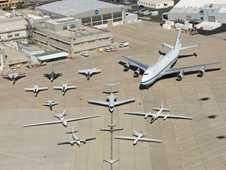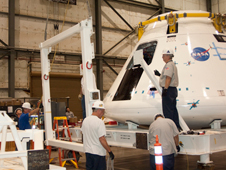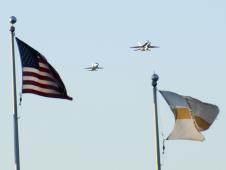NASA has awarded a follow-on contract to Computer Sciences Corp.'s Applied Technology Group of Fort Worth, Texas, to support the agency's aircraft used for astronaut training, flight research and miss...

en Español
Índice de los Páginas del Web de Dryden en Español
› Lea más
› La Misión Del Trasbordador STS-127
Dryden News
Latest News
NASA Awards Aircraft Maintenance Pact to Computer Scien...
Orion Abort Flight Test Crew Module Departs Dryden For ...
The Orion crew module that will be used for the first launch abort system Pad Abort 1 flight test is scheduled to depart NASA’s Dryden Flight Research Center Aug. 19 for the White Sands Missile Range,...
Aerospace Appreciation Night Flyover
Retired NASA astronaut, space shuttle commander and research pilot Gordon Fullerton discussed the legacy of the Apollo 11 moon landing recently before a standing-room-only audience of employees and ed...
News and Features
-

NASA Astronaut Vance Brand Plants ‘Moon Tree’ in Palmdale
Retired NASA Astronaut Vance Brand, (center), assisted by Steve Schmidt, director of NASA Dryden Aircraft Operations Facility and Mayor James Ledford of the City of Palmdale, Calif., planted a "Moon Tree" sycamore sapling at the AERO Institute in the Palmdale Civic Center.
-

Lancaster Jethawks Honor Last SR-71 Flight Crews
The last four crew members who flew aboard the famed triple-sonic Lockheed SR-71 Blackbird aircraft will be honored this Saturday evening, Aug. 15, by the Lancaster JetHawks baseball team during the team’s annual Aerospace Appreciation Weekend at Clear Channel Stadium in Lancaster.
-

Apollo's Legacy: Moon Missions Continue To Inspire The World
Retired NASA astronaut, space shuttle commander and research pilot Gordon Fullerton discussed the legacy of the Apollo 11 moon landing recently before a standing-room-only audience of employees and educators at NASA’s Dryden Flight Research Center.
-
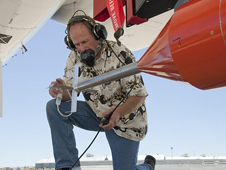
Rake Airflow Gage Experiment Flies Again on NASA F-15B
NASA's Dryden Flight Research Center recently conducted a flight test of an airflow-measurement device mounted underneath its F-15B research aircraft in the Rake Airflow Gage Experiment, or RAGE.
-

NASA's G-III and UAVSAR Conducting East Coast Vegetation Study
NASA's Gulfstream-III environmental science research aircraft is conducting a two-week radar imaging mission along the East Coast.
-

Collision Avoidance Technology Flying Again at Dryden
Dryden is working with the U.S. Air Force Research Laboratory to develop collision avoidance technologies for fighter/attack aircraft that would reduce the risk of ground and mid-air collisions in the Fighter Risk Reduction Project.
-

The LLRV / LLTV – Preparing Apollo’s Astronauts for Landing on the Moon
Following the challenge by President John F. Kennedy in 1962 to land a man on the moon and return him safely to Earth, two separate entities began working on a way to prepare astronauts for the critical descent and landing on the moon. The problems facing them were considerable: how to build a free-flying simulator that could negate 5/6ths of the Earth's gravity while entirely eliminating the effects of the atmosphere, since the moon had no atmosphere and only 1/6th of Earth's gravity.
Dryden Spotlight
-

STS-128
The STS-128 crew will deliver logistics and supplies to the International Space Station.
› Shuttle Mission Updates -

G-III Conducting East Coast Vegetation Study
NASA's Gulfstream-III environmental science aircraft is conducting an East Coast radar imaging mission.
› Mission Status Report
› G-III Photo Gallery -

Orion Crew Exploration Vehicle
NASA Dryden is leading the Orion crew module launch abort system flight test effort, including crew module systems integration for the first two flights.
› Read more
› Orion Photos
› Orion Movies -

SOFIA
NASA is developing the Stratospheric Observatory for Infrared Astronomy - or SOFIA - as a world-class airborne observatory that will complement the Hubble, Spitzer, Herschel and James Webb space telescopes and major Earth-based telescopes.
› Mission Update -

Dryden Aircraft Operations Facility
Our new aircraft operations facility in Palmdale offers the expanded space needed to manage Dryden's airborne science missions and research platforms.
-

Research Update
Current flight research projects and programs being flown at Dryden Flight Research Center.
-

This Week in Dryden's History
A collection of historical facts and events from Dryden's last 50 years.
-

50th Anniversary X-Press
Dryden has made many significant contributions to NASA's mission since the agency's inception five decades ago. The 50th anniversary issue of the X-Press profiles 61 employees and 28 current and past projects.
› Read 50th Anniversary X-Press
› View Special Photo Edition
Multimedia
-

Aircraft Imagery
Photos, video and graphics of Dryden aircraft



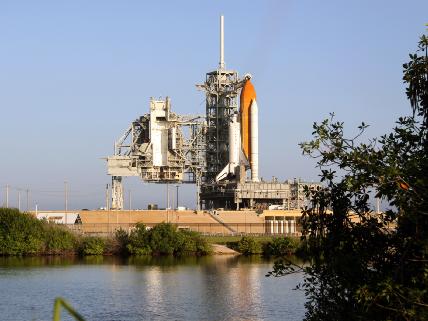 Space Shuttle Discovery sits on Launch Pad 39A after rollback of the rotating service structure, or RSS. Discovery's launch on mission STS-128 mission to the International Space Station has been reset for early morning Friday after a liquid hydrogen valve malfunction forced Tuesday's launch to be scrubbed. (NASA photo / Troy Cryder)
Space Shuttle Discovery sits on Launch Pad 39A after rollback of the rotating service structure, or RSS. Discovery's launch on mission STS-128 mission to the International Space Station has been reset for early morning Friday after a liquid hydrogen valve malfunction forced Tuesday's launch to be scrubbed. (NASA photo / Troy Cryder)